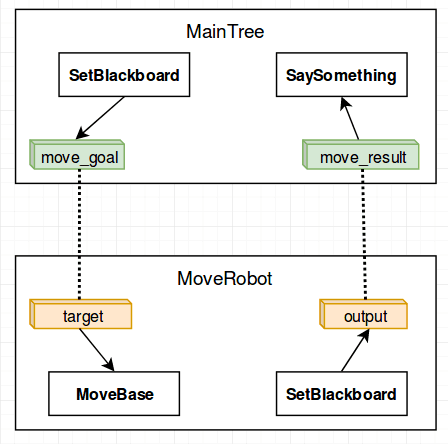翻译自:https://www.behaviortree.dev
Remapping ports between Trees and SubTrees [在树和子树之间重新映射端口]
In the CrossDoor example we saw that a SubTree looks like a single leaf Node from the point of view of its parent (MainTree in the example). [在 CrossDoor 示例中,我们看到从父节点(示例中的 MainTree)的角度来看,子树看起来像单个叶节点。]
Furthermore, to avoid name clashing in very large trees, any tree and subtree use a different instance of the Blackboard. [此外,为避免在非常大的树中出现名称冲突,任何树和子树都使用不同的 Blackboard 实例。]
For this reason, we need to explicitly connect the ports of a tree to those of its subtrees. [出于这个原因,我们需要将树的端口显式连接到其子树的端口。]
Once again, you won’t need to modify your C++ implementation since this remapping is done entirely in the XML definition. [再一次,您不需要修改 C++ 实现,因为重新映射完全在 XML 定义中完成。]
Example
Let’s consider this Beahavior Tree. [让我们考虑一下这个行为树。]
<root main_tree_to_execute = "MainTree">
<BehaviorTree ID="MainTree">
<Sequence name="main_sequence">
<SetBlackboard output_key="move_goal" value="1;2;3" />
<SubTree ID="MoveRobot" target="move_goal" output="move_result" />
<SaySomething message="{move_result}"/>
</Sequence>
</BehaviorTree>
<BehaviorTree ID="MoveRobot">
<Fallback name="move_robot_main">
<SequenceStar>
<MoveBase goal="{target}"/>
<SetBlackboard output_key="output" value="mission accomplished" />
</SequenceStar>
<ForceFailure>
<SetBlackboard output_key="output" value="mission failed" />
</ForceFailure>
</Fallback>
</BehaviorTree>
</root>
You may notice that: [您可能会注意到:]
- We have a
MainTreethat includes a subtree calledMoveRobot. [我们有一个 MainTree,其中包含一个名为 MoveRobot 的子树。] - We want to “connect” (i.e. “remap”) ports inside the
MoveRobotsubtree with other ports in theMainTree. [我们希望将 MoveRobot 子树中的端口与 MainTree 中的其他端口“连接”(即“重新映射”)。] - This is done using the XMl tag , where the words internal/external refer respectively to a subtree and its parent. [这是使用 XMl 标记完成的,其中内部/外部词分别指子树及其父树。]
The following image shows remapping between these two different trees. [下图显示了这两个不同树之间的重新映射。]
Note that this diagram represents the dataflow and the entries in the respective blackboard, not the relationship in terms of Behavior Trees. [请注意,此图表示相应黑板上的数据流和条目,而不是行为树方面的关系。]

In terms of C++, we don’t need to do much. For debugging purpose, we may show some information about the current state of a blackboard with the method debugMessage(). [在 C++ 方面,我们不需要做太多事情。出于调试目的,我们可以使用 debugMessage() 方法显示有关黑板当前状态的一些信息。]
int main()
{
BT::BehaviorTreeFactory factory;
factory.registerNodeType<SaySomething>("SaySomething");
factory.registerNodeType<MoveBaseAction>("MoveBase");
auto tree = factory.createTreeFromText(xml_text);
NodeStatus status = NodeStatus::RUNNING;
// Keep on ticking until you get either a SUCCESS or FAILURE state
while( status == NodeStatus::RUNNING)
{
status = tree.tickRoot();
// IMPORTANT: add sleep to avoid busy loops.
// You should use Tree::sleep(). Don't be afraid to run this at 1 KHz.
tree.sleep( std::chrono::milliseconds(1) );
}
// let's visualize some information about the current state of the blackboards.
std::cout << "--------------" << std::endl;
tree.blackboard_stack[0]->debugMessage();
std::cout << "--------------" << std::endl;
tree.blackboard_stack[1]->debugMessage();
std::cout << "--------------" << std::endl;
return 0;
}
/* Expected output:
[ MoveBase: STARTED ]. goal: x=1 y=2.0 theta=3.00
[ MoveBase: FINISHED ]
Robot says: mission accomplished
--------------
move_result (std::string) -> full
move_goal (Pose2D) -> full
--------------
output (std::string) -> remapped to parent [move_result]
target (Pose2D) -> remapped to parent [move_goal]
--------------
*/





















 671
671











 被折叠的 条评论
为什么被折叠?
被折叠的 条评论
为什么被折叠?








